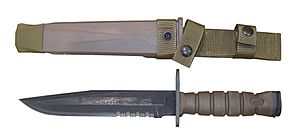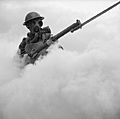Bayonet facts for kids

A bayonet is a special type of knife or dagger. It is made to be attached to the end of a rifle. This turns the rifle into a kind of spear. Bayonets are used for fighting up close, especially if a soldier runs out of bullets. The word "bayonet" comes from the French word baïonnette.
What is a Bayonet Charge?
In the 1700s and 1800s, armies often used bayonets in a special attack called a bayonet charge. This was when many infantry soldiers, with bayonets fixed to their muskets, would run towards the enemy. They usually charged over short distances. The goal was to quickly take over enemy positions, capture cannons, or break up enemy groups.
Using bayonets meant that soldiers could defend themselves from cavalry (soldiers on horseback). Before bayonets, soldiers often used long spears called pikes for defense. But with bayonets, infantry could fight off cavalry without losing their ability to shoot.
The Russian Army used bayonet charges very often during the Napoleonic Wars. A famous Russian general, Alexander Suvorov, once said, "The bullet is foolish, the bayonet wise." This was because Russian armies sometimes had less training and their muskets were not very accurate. So, Russian officers often preferred to use bayonet charges instead of just shooting their guns.
Images for kids
-
British infantryman in 1941 with a Pattern 1907 bayonet affixed to his rifle
-
A bayonet charge during the Battle of Großbeeren (1813)
-
A stretch of no man's land in Flanders Fields, France, 1919
-
A life-size diorama at the US Army Infantry Museum, Fort Benning, Georgia, depicting Millett's charge up Hill 180 during the Korean War that resulted in his receipt of the Medal of Honor.
See also
 In Spanish: Bayoneta para niños
In Spanish: Bayoneta para niños















